-
Posts
1,253 -
Joined
-
Last visited
-
Days Won
8
Content Type
Profiles
Forums
Events
Store
Downloads
Gallery
Posts posted by DTM72
-
-
Antler may actually have the slight brownish colorization of older same' and be a good match. Got me thinking now...
-
As for ivory, I see old pianos being sold that most likely have real ivory keys. The broken ones go very cheap. Just a thought for material purposes.
-
 1
1
-
-
Any updates on when we will receive the actual papers?
-
After chatting with Mark, I will have a table in Vegas!
Look forward to meeting fellow NMB members.
-
-
I agree with Brian, the starting price on all three is reasonable. I would think that with the other offerings being of good to excellent quality, these 3 swords will end up double or triple the starting bid price.
Wishing you the best.
-
@Mark Thanks for all the updates!
-
8 hours ago, Bruce Pennington said:
Does this mean the 4,800 were unfinished? That would line up, like you said, with the '44 figures of 500 finished and 5,500 unfinished.
I'm still amazed that in the last two years of the war Japan was actually increasing their sword/weapon production.
They were preparing for the Allied land invasion. The US has a gun behind every blade of grass...the Japanese would have had a blade behind every blade of grass.
-
I agree with Christian, it is an unokubi-zukuri but with kogarasu-maru style. can honestly say I have never seen this done before. Correct example linked below. I believe this may have been a Murata or Zohito blade originally mounted in a Type 19 kyugunto mounting causing the nakago to be odd shaped. I also guess that it was re-fitted to a type 98 mounting probably by the seller. Looking closely at the tsuka, the ito looks to have been pushed too far away from the fuchi. Under the ito is shagreen (sharkskin) instead same' (rayskin), so a tiny bit of rarity there. 4 of the seppa are definately Chinese pieces, but the pierced tsuba and copper seppa look to be good quality type 94. Tassel looks to be correct for company grade officer.
Maybe our resident experts can help a little more on this one. @Bruce Pennington @george trotter @Kiipu
-
 1
1
-
-
Based only on signature style, I would guess Nidai Shigetaka.
-
-
Anyone else plan to attend or exhibit at this show? Trying to decide what to take for sale or trade as I'm just going to be walking around. (No Table)
-
 1
1
-
-
On 12/10/2022 at 5:26 AM, PNSSHOGUN said:
Nice chance to get a copy from Mr Dawson, I'm sure he might even sneak an autograph in there too!
I did exactly that John. Jim signed the inside cover for me.
-
Didn't see them on your website Gray. If anyone is interested, buy the copies Gray has first! If any additional copies are wanted, I can arrange the sales with Mr. Dawson.
-
I have been in the market for a "reasonable" priced version of this book for a while. I was finding used copies available for $250 - $500. I was able to find a NEW copy for $175 and was told there are more available, by the seller..Mr. Jim Dawson himself. Would anyone else be interested in a copy at that price?
-
 1
1
-
 1
1
-
-
-
 2
2
-
-
Best I can tell from the pics.
井戸秀俊
Ido Hidetoshi
Hard to see the last character. It has the Showa stamp so it dates from 1938-1945. I would guess closer to 1940-1942. Non-Traditional machine made blade.
Born in 1915. Hidetoshi worked at Fukumoto Amahide's guntō factory located in Seki, Gifu.
@Bruce Pennington knows more about the stamps and the dates they were used.
-
 1
1
-
-
I have been collecting for over 25 years. Seen many variations in-hand. I also have Fuller & Gregory books as well as the Jim Dawson books for reference. Lastly, we both have access to the NMB for guys far more knowledgeable!
As for the seppa, get a 4-5 pieces. They vary in thickness and will probably need to be stacked to make-up for the thick leather seppa. I don't normally recommend eBay but for things like seppa, it is a good place.
Another japanese seller with good quality replica pieces. https://www.ebay.com/itm/285062558211?hash=item425f0d7203:g:cZ0AAOSwCBtjbJN0&amdata=enc%3AAQAHAAAA0IUIN1%2Fvaj3o8OH5Ff3fOfNfJ0hH6lkjuBkEg0ImdWOaiTnYGzXhJAp583raUVI%2BK%2FWE8dsujhxdKMFPUl3OpdEr%2FH%2FtEWX9%2FBh4M7KPxalpF92VepmHVHKlr3YR5Nwd0kl4SfJ%2FVnoFKnCV4MjJ0rTNlGSRF73VpZFvNkWmlH2rhl%2F5S5sN8IMpC3eMhEicGsLAVKDS6epqCqr4qkpGvi2I%2FBjV5MkgAxadr2P0W9ltYGM07zLgeKd8osMT0G4ynSo3d7SVRvt%2FyaRV98r3fo0%3D|tkp%3ABk9SR77G9q2eYQ
Chinese seller but has good quality replica stuff
https://www.ebay.com/itm/255188067309?hash=item3b6a64e3ed:g:YjAAAOSwoJ5eoByH
https://www.ebay.com/itm/255793809994?hash=item3b8e7fca4a:g:DUsAAOSwAG9fK-LU
https://www.ebay.com/itm/255225747505?hash=item3b6ca3d831:g:7~sAAOSw955fbbF3
Another Chinese Seller with a replica Sakura mekugi for the center of the tsuka. https://www.ebay.com/itm/194712970083?hash=item2d55cc2363:g:begAAOSwpzhgiOqR
-
A Gassan blade in Kyu mounts with Gassan horimono?

-
 1
1
-
-
Lastly, I will say, this is NOT a fake kyu-gunto. It is 100% authentic Type 8. It does NOT have the desireable remounted Nihonto as others do. With some quality brass seppa and a good fitting mekugi fitted, this will be a decent outfit. If this is your first Japanese sword, there is not much to learn about nihonto from this. If you paid $500 for it, you did ok. (Not great but not bad) The parade sabers with a chrome plated blade, dull edge and acid etched hamon are selling for $250-$350.
Wishing you the best.
Dan
-
5 hours ago, Bridges said:
there is no signature on the nakago but a cross like marking. At the end of the nakago is not uniform, a piece of square steel is jutting out. It almost seems intentional? The nakago has three holes but there is only one mekugi going through the hole closest to the blade.
There are filing marks that appear to be present when I remove the handle on the Nakago closest to the end of the blade.
I heard the cross looking mark is the sign of blades cut down but I’m not sure.
The Cross type marking looks like katakana (Japanese symbols for sounding out words of foreign origin) I have a smaller one on one of mine that is the katakana symbol for "MO" My blade that has the MO symbol happens to be a Murata blade. 村田刀. Looking at your blade, it looks to be either a Zohito 造兵刀 or a Murata. Zoheito were designed to be a mass produced arsenal blade. Your blade does not appear to have a hamon or jihada so that leads me to believe this is a machine made blade.
-
4 hours ago, Bridges said:
Upon removing the blade from the packaging, I noticed the hilt was loose on the blade.
a few things seemed off. The first things being the fittings had notches for where the scabbard locks up with the handle. However, that mechanism on NCO swords is not present on this one. So two of the fittings seem to not match the sword.
Looking at the end of your handle core, there is no slot cut into the wood for the release mechanism. Additionally the fuchi does not have a hole for the release button either. Best I can tell, there does not seem to be a square notch in the tsuba (handguard) part of the D-Ring. All that being said, this particular sword was NOT designed to have a release button. So your thoughts of the 2 seppa (spacers) being incorrect, is spot-on. Additional seppa (without the square notch) will be required to tighten-up the tsuka (handle) to the habaki. I may be incorrect but I do not think leather seppa were used on the this type of blade. I have seen them used on the calavry swords and the parade sabers, but not on this type. <-- Not 100% sure on that one. With additional brass seppa, the mounts will tighten-up nicely. <-- easy fix.
-
5 hours ago, Bridges said:
As I removed the handle, I could not tell if the handle is bone or plastic but I believe it to be plastic. Is this common for early swords in the 1900s?
The nakago has three holes but there is only one mekugi going through the hole closest to the blade. Apparently where the chrysanthemum is where the second mekugi would be appears to be filled in on one side by some type of metal.
The mekugi for sticking out one side of the blade and appear to be fractured
I'll address your concerns on the items I can help with.
Per your pics below, the same' skin was originally painted black, then polished down to remove the high spots. It may feel plasticky to you, but it is 100% real and original to the handle. It also looks as if the original 2 piece brass mekugi was broken/lost so the hole was plugged to keep the backstrap attached to the handle core. Looking closely at the part where the D-Ring inserts into the handle core, the large node of the ray skin are noticable.
The hole in the tsuka appears to lin-up well with the hole in the nakago. I would venture to say that the mekugi was crudely fashioned by someone to somewhat do the job of holding things together. True mekugi should be made of susudake (smoked bamboo). This has increased strength properties over just raw un-cured bamboo. But since these are not used as weapons of war any longer, most collectors will get a good bamboo chopstick that is tapered, and insert inside the hole, mark the length, remove and cut length, and file ends repeatedly until the mekugi is flush with the surface on both sides.
-
I saw this sold for $1600. <-- not bad for a non-satinless Type 97 in good mounts. Did you get it or pass?


.thumb.jpg.bc10b59027a00aa142dce0349f3ba9e0.jpg)





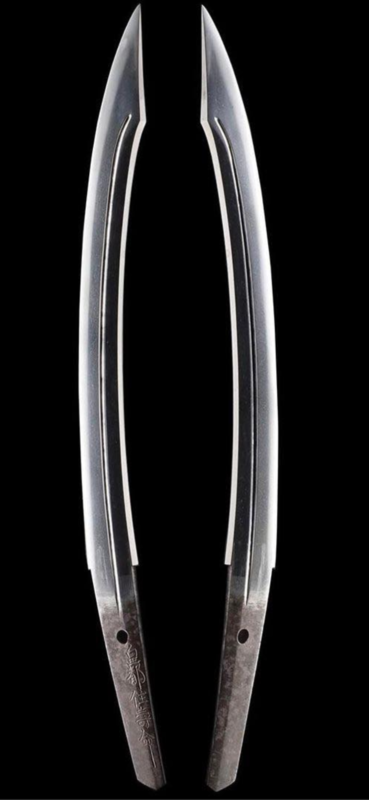






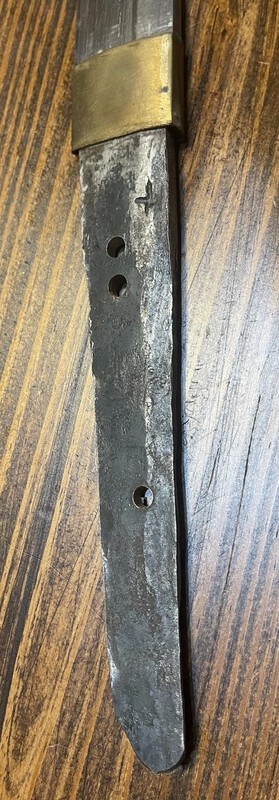
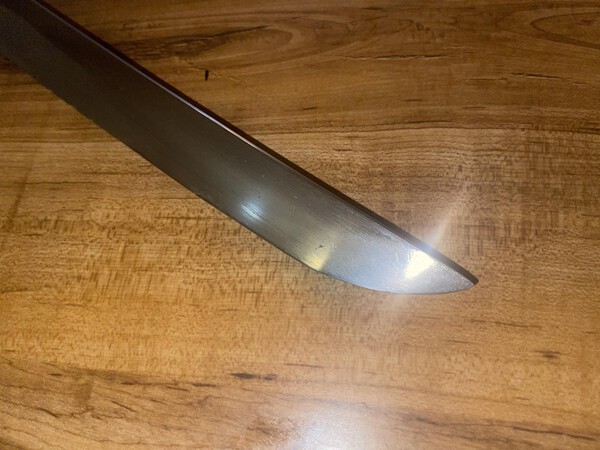
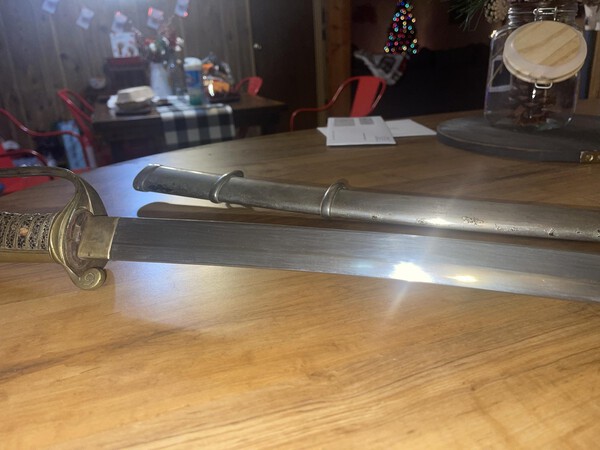




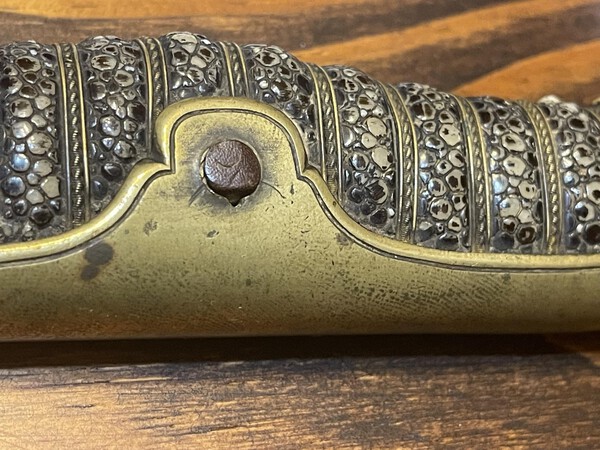
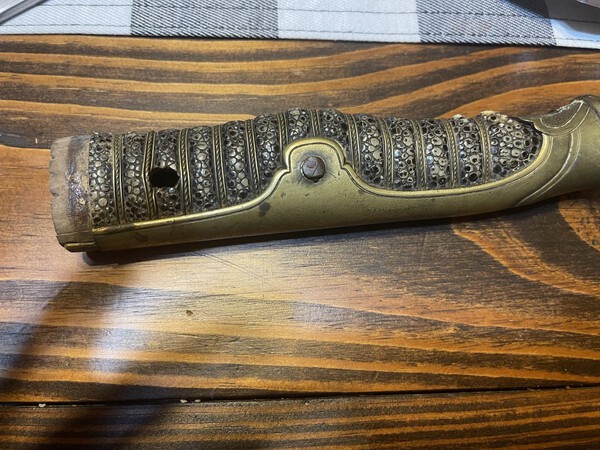

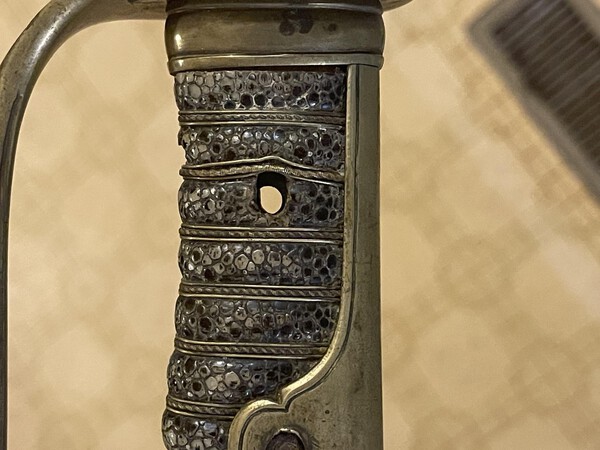
Any idea as to the maker? Here's one I can't find in any of my books.
in Translation Assistance
Posted
I owned a wakizashi by nidai shigetaka. Due to the shorter nakago, Echizen Jyu was on the opposite side of the Harima Daijo Fujiwara Shigetaka. Does yours have Echizen Jyu on the opposite side?